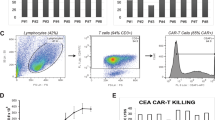Abstract
We tried a infusion of interleukin-2 (IL-2) of a relatively low dose via an intrasplenic arterial catheter connected to a chronometric infusion (IS-IL-2). Eighteen patients of colorectal cancer with metastases to the liver or lung or of unresectable hepatoma received a 24 hour continuous infusion with low dose recombinant of IL-2 (mainly 8 × 105 JRU/day) for 25–40 days. All patients tolerated this protocol of the therapy and the main toxic effects were fever and general fatigue. Such serious toxicity as previously reported by high dose IL-2 therapy was not observed. Data of hepatic and renal functions were normal. IS-IL-2 therapy induced a high incidence of eosinophilia (12/18) and thrombocythemia (12/18). Peripheral natural killer (NK) and LAK activities were augmented in all patients and total white blood cell counts were increased during IS-IL-2 therapy. An increase in IL-2 receptor expression of peripheral blood mononuclear cells and significant rises in numbers of Leull (CD16)+, OKMl(CD11)+ and OKIal(HLA-DR)+ were observed. Of 18 patients 12 were evaluable for their response to therapy. Partial response (PR) was observed in one unresectable hepatoma and 11 demonstrated no change (NC) or progressive disease (PD). Six patients were not evaluable because of additional therapy (3 cases) or decreasing tumor cell markers having no measurable lesions (3 cases). Three patients of colorectal cancer from an unresectable group were presumed to have micrometastases to the liver as suggested by an elevated serum CEA level. After receiving IS-IL-2 therapy they demonstrated a decrease in the serum CEA level for more than 3 years after treatment. We conclude that continuous IS-IL-2 administration can result in an increase of their therapeutic efficacy of IL-2 administration and in a decrease its toxicity.
Similar content being viewed by others
Abbreviations
- CEA:
-
carcinoembryonic antigen
- IL-2:
-
interleukin-2
- IS-IL-2:
-
intrasplenic arterial infusion of IL-2
- LAK:
-
lymphokine-activated killer
- LGL:
-
large granular lymphocyte
- MHC:
-
major histocompatibility complex
- NC:
-
no change
- NK:
-
natural killer
- PBMC:
-
peripheral blood mononuclear cell
- PD:
-
progressive disease
- PR:
-
partial response
References
Okuno K, Takagi H, Nakamura Y, Iwasa Z, Yasutomi M. Treatment for unresectable hepatoma via selective hepatic arterial infusion of lymphokine-activated killer cells generated from autolougous spleen cells. Cancer 1986; 58: 1001–6.
Ebihara T, Koyama S, Fukao K, Osuga T. Effector function of cytokine-activated spleen cells in patients with gastric or hepatocellular carcinoma and immunological phenotypic analysis of these cells. Biotherapy 1989; 3: 675–83.
Ohnishi H. An experimental study on thein vivo induction of lymphokine-activated killer (LAK) cells by the continuous infusion of interleukin-2 (IL-2) through the splenic artery. J Jpn Soc Cancer Ther 1988; 23: 2785–93.
Kato K, Yamada T, Kawahara K, Onda H, Asano T, Sugino H, Kakinuma A. Purification and characterization of recombinant human interleukin-2. Biochem Biophys Res Commun 1985; 130: 692–7.
Rosenberg SA, Lotze MT, Muul LM, Chang AE, Avis FP, Leitman S, Linehan WM, Robertson CN, Lee RE, Rubin JT, Seipp CA, Simpson CG, White DE. A progress report the treatment of 157 patients with advanced cancer using lymphokine-activated killer cells and interleukin-2 or high-dose interleukin-2 alone. N Engl J Med 1987; 316: 889–97.
West WH, Tauer KW, Yannelli JR, Marshall GD, Orr DW, Thurman GB, Oldham RK. Constant infusion of recombinant interleukin-2 in adoptive immunotherapy of advanced cancer. N Engl J Med 1987; 316: 898–905.
Thompson JA, Lee DJ, Lindgren CG, Benz LA, Collins C, Levitt D, Fefer, A Influence of dose and duration of infusion of interleukin-2 on toxicity and immunomodulation. J Clin Oncol 1988; 6: 669–78.
Lotze MT, Robb RJ, Sharrow SO, Frana LW, Rosenberg SA. Systemic administration of interleukin-2 in humans. J Biol Response Mod 1984; 3: 475–82.
Atkins MB, Gould JA, Allegretta M, Li JJ, Dempsey RA, Rudders RA, Parkinson DR, Reichlin S, Mier JW. Phase I evaluation of recombinant Interleukin-2 in patients with advanced malignant disease. J. Clin Oncol 1986; 4: 1380–91.
Damle NK, Doyle LV, Bradley EC. Interleukin-2 activated human killer cells derived from phenotypically heterogenous precursors. J Immunol 1986; 137: 2814–22.
Ortaldo JR, Mason A, Overton R. Lymphokine-activated killer cells. Analysis of progenitors and effectors. J Exp Med 1986; 164: 1193–205.
Roberts K, Lotze MT, Rosenberg SA. Separation and functional studies of the human lymphokine-activated killer cells. Cancer Res 1987; 49: 4366–71.
Tilden AB, Itoh K, Balch CM. Human lymphokineactivated killer (LAK) cells: identification of two types of effector cells. J Immunol 1987; 138: 1068–73.
Ferrini S, Miescher S, Zocchi MR, von Fliedner V, Morreta A. Phenotypic and functional characterization of recombinant interleukin-2 (rIL-2)-induced activated killer cells: analysis at the population and clonal levels. J Immunol 1987; 138: 1297–302.
Astler CV, Coller FA. Prognostic significance of direct extension of carcinoma of colon and rectum. Ann Surg 1954; 139: 846–51.
Kaneda K, Wake K. Distribution and morphological characterization of the pit cells in the liver of the rat. Cell Tissue Res 1983; 233: 485–505.
Bouwens L, Remels L, Wisse E. Large granular lymphocytes or “Pit cells' from rat liver: isolation, ultrastructural characterization and natural killer activity. Eur J Immunol 1987; 17: 27–42.
Okuno K, Ohnishi H, Nakamura T, Kokudo S, Yasutomi M. Injection of interleukin-2 (IL-2) into the tumor-bearer's spleen augments lymphokine-activated killer (LAK) activityin vivo and inhibits tumor metastasis. J Jap Surg Soc 1987; 88: 802–7. (in Japanese)
Okuno K, Nakamura T, Nakamura Y, Nakajima I, Ohnishi H, Yasutomi M. Cytotoxic activity of LAK cells in the liver after intrasplenic injection of LAK cells and IL-2. Igaku no ayumi 1988; 147: 923–4. (in Japanese)
Author information
Authors and Affiliations
Rights and permissions
About this article
Cite this article
Okuno, K., Ohnishi, H., Koh, K. et al. Clinical trials of intrasplenic arterial infusion of interleukin-2 (IS-IL-2) to patients with advanced cancer. Biotherapy 4, 257–265 (1992). https://doi.org/10.1007/BF02172655
Received:
Accepted:
Issue Date:
DOI: https://doi.org/10.1007/BF02172655




